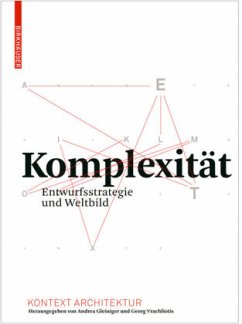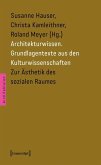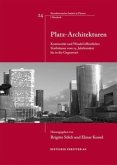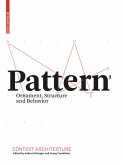Digitalization has transformed the discourse of architecture: that discourse is now defined by a wealth of new terms and concepts that previously either had no meaning, or had different meanings, in the context of architectural theory and design. Its concepts and strategies are increasingly shaped by influences emerging at the intersection with scientific and cultural notions from modern information technology. The series Context Architecture seeks to take a critical selection of concepts that play a vital role in the current discourse and put them up for discussion.
When Vitruvius described the architect as a "uomo universale," he gave rise to the architect’s conception of him- or herself as a generalist who shapes a complex reality. The architectural concept of complexity, however, failed to keep pace with industrial and social reality, becoming instead an increasingly formal and superficial notion that could ultimately be applied to almost anything.
Against it, architectural modernism set the watchword of simplification: "less is more." In this situation, Robert Venturi reintroduced the notion of complexity into architectural discourse: his goal was not just to restore the complexity of architectonic forms and their history but also to explore the concrete reality of the existing built environment.
Today it is complexity studies, with their starting point in physics, that define the current approach to the concept of complexity. They have established a new connection between the natural sciences and information technology and have thus become a central premise of computer-based approaches to design.
Die Digitalisierung hat den Diskurs der Architektur verändert: Dieser ist mittlerweile von einer Fülle neuer Begriffe bestimmt, die bislang entweder keine oder doch andere Bedeutungen im Kontext der Architekturtheorie und des architektonischen Entwurfs hatten. Seine Begrifflichkeiten und Strategien werden zunehmend durch Einflüsse geprägt, die an der Schnittstelle zu wissenschaftlichen und kulturellen Vorstelllungen der modernen Informationstechnologie entstehen. Ziel der neuen Reihe Kontext Architektur ist es deshalb, eine kritische Auswahl jener Begriffe zur Debatte zu stellen, die im aktuellen Diskurs eine Rolle spielen.
Als Vitruv den Architekten als "uomo universale" beschrieb, schuf erdessenSelbstverständnis als eines Generalisten, der eine komplexe Realität gestaltet. Der architektonische Begriff der Komplexitäthielt allerdings mit der industriell-gesellschaftlichenWirklichkeit nicht Schritt, er verflachte zu einer formalen Beliebigkeit. Die architektonische Moderne setzte dagegen die Vereinfachung "Less is More". Vor diesem Hintergrundführte Robert Venturi den Begriff in den Architekturdiskurs neu ein: Es ging dabei nicht nur um eine Wiedergewinnung der Komplexität der architektonischen Formen und ihrer Geschichte, sondern auch um das Eingehen auf das Vorgefundene als konkrete Realität.
Heute prägt die Komplexitätsforschung, ausgehend von der Physik, den aktuellen Umgang mit dem Begriff der Komplexität. Siehat eine neueVerbindung zwischen Naturwissenschaften und Informationstechnologie geknüpft und ist sozu einer zentralenVoraussetzung computerbasierter Entwurfskonzepte geworden.
When Vitruvius described the architect as a "uomo universale," he gave rise to the architect’s conception of him- or herself as a generalist who shapes a complex reality. The architectural concept of complexity, however, failed to keep pace with industrial and social reality, becoming instead an increasingly formal and superficial notion that could ultimately be applied to almost anything.
Against it, architectural modernism set the watchword of simplification: "less is more." In this situation, Robert Venturi reintroduced the notion of complexity into architectural discourse: his goal was not just to restore the complexity of architectonic forms and their history but also to explore the concrete reality of the existing built environment.
Today it is complexity studies, with their starting point in physics, that define the current approach to the concept of complexity. They have established a new connection between the natural sciences and information technology and have thus become a central premise of computer-based approaches to design.
Die Digitalisierung hat den Diskurs der Architektur verändert: Dieser ist mittlerweile von einer Fülle neuer Begriffe bestimmt, die bislang entweder keine oder doch andere Bedeutungen im Kontext der Architekturtheorie und des architektonischen Entwurfs hatten. Seine Begrifflichkeiten und Strategien werden zunehmend durch Einflüsse geprägt, die an der Schnittstelle zu wissenschaftlichen und kulturellen Vorstelllungen der modernen Informationstechnologie entstehen. Ziel der neuen Reihe Kontext Architektur ist es deshalb, eine kritische Auswahl jener Begriffe zur Debatte zu stellen, die im aktuellen Diskurs eine Rolle spielen.
Als Vitruv den Architekten als "uomo universale" beschrieb, schuf erdessenSelbstverständnis als eines Generalisten, der eine komplexe Realität gestaltet. Der architektonische Begriff der Komplexitäthielt allerdings mit der industriell-gesellschaftlichenWirklichkeit nicht Schritt, er verflachte zu einer formalen Beliebigkeit. Die architektonische Moderne setzte dagegen die Vereinfachung "Less is More". Vor diesem Hintergrundführte Robert Venturi den Begriff in den Architekturdiskurs neu ein: Es ging dabei nicht nur um eine Wiedergewinnung der Komplexität der architektonischen Formen und ihrer Geschichte, sondern auch um das Eingehen auf das Vorgefundene als konkrete Realität.
Heute prägt die Komplexitätsforschung, ausgehend von der Physik, den aktuellen Umgang mit dem Begriff der Komplexität. Siehat eine neueVerbindung zwischen Naturwissenschaften und Informationstechnologie geknüpft und ist sozu einer zentralenVoraussetzung computerbasierter Entwurfskonzepte geworden.








